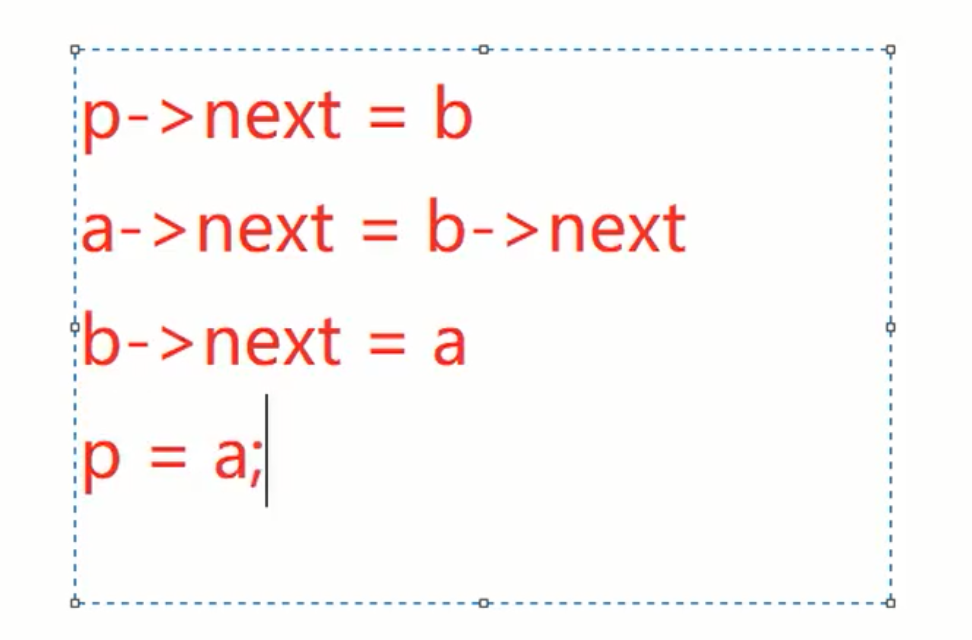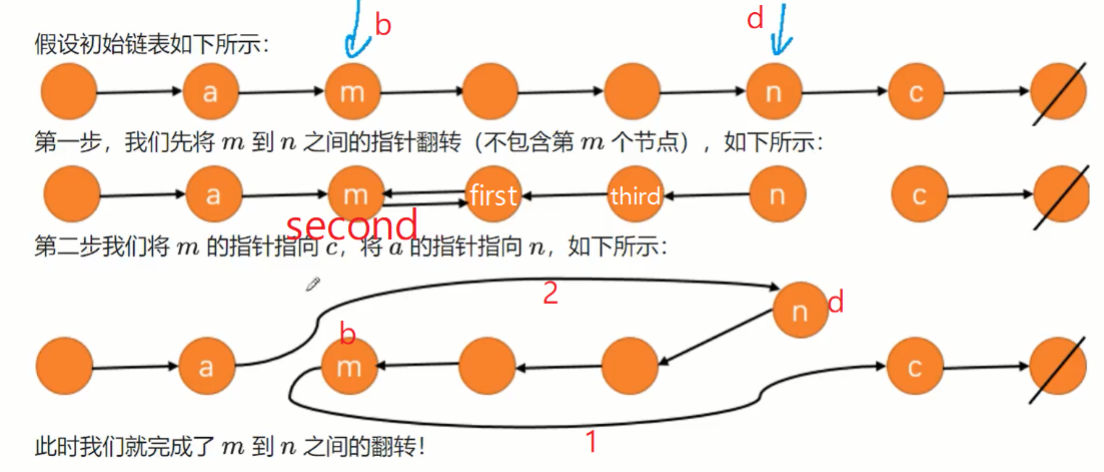LeetCode链表专题
链表
套路总结
1.多个指针 移动
2.虚假链表头:凡是有可能删除头节点的都创建一个虚拟头节点,代码可以少一些判断(需要用到首部前一个元素的时候就加虚拟头指针)

3.快慢指针
如leetcode142 快慢指针找链表环的起点
19. 删除链表的倒数第N个节点
题目要求:只扫描一遍
删除链表,肯定要找到被删节点的前一个节点

1.找到倒数第n个节点的前一个节点(倒数第n+1)
2.双指针
first指针指向第k个,second头指针指向虚假头节点,两个指针一起移动,当first指针指向最后一个节点的时候(first下一个节点为NULL),就说明second到达了倒数第k个节点
3.删除即可 second ->next = second->next->next

/*** Definition for singly-linked list.* struct ListNode {* int val;* ListNode *next;* ListNode(int x) : val(x), next(NULL) {}* };*/class Solution {public:ListNode* removeNthFromEnd(ListNode* head, int n) {auto dummy = new ListNode(-1);dummy->next = head;auto first = dummy;auto second = dummy;while(n--) first = first->next;while(first->next != NULL){second = second->next;first = first->next;}second->next = second->next->next;return dummy->next;}};
237. 删除链表中的节点
例如,给定node指向5这个点,删除5这个点

真正意义删除要知道被删除节点的上一个点
假装删除,把这个点的值伪装成下一个点的值,把下一个点删掉即可

/*** Definition for singly-linked list.* struct ListNode {* int val;* ListNode *next;* ListNode(int x) : val(x), next(NULL) {}* };*/class Solution {public:void deleteNode(ListNode* node) {if(node->next){node->val = node->next->val;node->next = node->next->next;}return;}};
C++语法把node两个属性的值都一起替换为下一个节点的属性

*(node) = *(node->next);
83. 删除排序链表中的重复元素

/*** Definition for singly-linked list.* struct ListNode {* int val;* ListNode *next;* ListNode(int x) : val(x), next(NULL) {}* };*/class Solution {public:ListNode* deleteDuplicates(ListNode* head) {auto *first = head;while(first && first->next){if(first->val == first->next->val){first->next = first->next->next;}else{first = first->next;//这里first可能移动到了空 所以要判断first是否空}}return head;}};
82. 删除排序链表中的重复元素 II

/*** Definition for singly-linked list.* struct ListNode {* int val;* ListNode *next;* ListNode(int x) : val(x), next(NULL) {}* };*/class Solution {public:ListNode* deleteDuplicates(ListNode* head) {auto dummy = new ListNode(-1);dummy->next = head;auto pre = dummy,cur = pre->next;int cnt = 0;while(pre && cur){cnt = 0;auto nxt = cur->next;while(nxt && nxt->val == cur->val) {cnt++;nxt = nxt->next;}if(cnt >= 1){pre->next = nxt;cur = pre->next;}else{pre = pre->next;cur = pre->next;}}return dummy->next;}};
61. 旋转链表
两个指针,距离为k
(不需要用到虚拟头节点,头节点会改变时用到)


之后让first->next指向开头head,再让head指向现在的头(second->next)!
再让second->next指向空
/*** Definition for singly-linked list.* struct ListNode {* int val;* ListNode *next;* ListNode(int x) : val(x), next(NULL) {}* };*/class Solution {public:ListNode* rotateRight(ListNode* head, int k) {if(!head) return NULL;int n = 0;for(auto p = head;p;p=p->next) n++;k %= n;auto first = head,second = head;while(k--) first = first->next;while(first->next){first=first->next;second=second->next;}first->next = head;head = second->next;second->next = NULL;return head;}};
24. 两两交换链表中的节点
1.建立虚拟头节点,因为头节点可能会改变
2.三个指针


/*** Definition for singly-linked list.* struct ListNode {* int val;* ListNode *next;* ListNode(int x) : val(x), next(NULL) {}* };*/class Solution {public:ListNode* swapPairs(ListNode* head) {auto dummy = new ListNode(-1);dummy->next = head;for(auto p = dummy;p->next && p->next->next;){auto a = p->next,b = a->next;p->next = b;a->next = b->next;b->next = a;p = a; //指向下一个新的两对前的最后一个点}return dummy->next;}};
206. 反转链表
两个翻转指针a,b;一个保留指针c保留b后面的链防止被删除,不需要虚拟头节点因为不需要用到首部前一个
分三步

/*** Definition for singly-linked list.* struct ListNode {* int val;* ListNode *next;* ListNode(int x) : val(x), next(NULL) {}* };*/class Solution {public:ListNode* reverseList(ListNode* head) {if(!head) return NULL;auto a = head,b = head->next;while(b){auto c = b->next;b->next = a;a = b;b = c;}head->next = NULL;//原来头是原来的第一节点 现在的最后一个节点所以指向空head = a;return head;}};
92. 反转链表 II
1.因为头节点会发生变化,设置虚拟头节点
2.a指针移动到翻转前一个点,b指针移动第一个翻转的点,d指针移动到最后一个翻转的点。c指针指向最后一个翻转的点的下一个点。然后翻转b~d之间的点和206题一样
3.连接a->d,b->c

/*** Definition for singly-linked list.* struct ListNode {* int val;* ListNode *next;* ListNode(int x) : val(x), next(NULL) {}* };*/class Solution {public:ListNode* reverseBetween(ListNode* head, int m, int n) {if(m == n) return head;auto dummy = new ListNode(-1); //虚拟头节点dummy->next = head;//找到a和dauto a = dummy,d = dummy;for(int i=0;i<m-1;i++) {a = a->next;//不设置虚拟头节点的话,如果n=1就找不到了a}for(int i=0;i<n;i++) d = d->next;//找到b和cauto b = a->next, c = d->next;//翻转b和d之间的数字for(auto first = b->next,second = b; first != c;){auto third = first->next;first->next = second;second = first,first = third;}//连接b->next = c;a->next = d;return dummy->next;}};
160. 相交链表
相遇:当指针p和指针q走的路程相等时相遇
考虑都走a+b+c的倍数,肯定会相遇

/*** Definition for singly-linked list.* struct ListNode {* int val;* ListNode *next;* ListNode(int x) : val(x), next(NULL) {}* };*/class Solution {public:ListNode *getIntersectionNode(ListNode *headA, ListNode *headB) {auto tempHeadA = headA;auto tempHeadB = headB;while(tempHeadA != tempHeadB){if(tempHeadA) tempHeadA = tempHeadA->next;else tempHeadA = headB;if(tempHeadB) tempHeadB = tempHeadB->next;else tempHeadB = headA;}return tempHeadB;}};
142. 环形链表 II
快慢指针
1.快指针慢指针从head头部出发,fast快指针每次走两步,slow慢指针每次走一步直到相遇。
2.把其中一个指针移动到head头部,快慢指针再每次走一步直到相遇,相遇点即为答案;

证明:利用快指针走动过的是慢指针的二倍,假设环起点坐标为x,第一次相遇点距离换起点距离为y。
可列公式2×(x+n1×c+y)=x+y+n2×c ,化简得x+y=(n2-n1)×c。
大白话说就是:非环部分的长度+环起点到相遇点之间的长度就是环的整数倍。
即x+y为环的整数倍
那么第一次相遇时我们现在距离环起点为y,所以只要再走x就到环起点了
再走x的话就让一个指针从head走,另一个从第一次相遇点走,每次都走1步
/*** Definition for singly-linked list.* struct ListNode {* int val;* ListNode *next;* ListNode(int x) : val(x), next(NULL) {}* };*/class Solution {public:ListNode *detectCycle(ListNode *head) {auto fast = head,slow = head;while(fast && fast->next){fast = fast->next;fast = fast->next; //快指针移动两次slow = slow->next; //慢指针移动1次if(fast == slow){ //当快慢指针相遇时退出break;}}if(fast==NULL || fast->next == NULL)return NULL;else{slow = head; //让其中一个指针移动到头部while(fast != slow){ //再走到相遇点即可fast = fast->next;slow = slow->next;}return slow;}}};
148. 排序链表
要求空间常数,时间O(nlogn)
因为快排用到递归(栈),空间为logn;递归版归并空间消耗大;所以用迭代版归并
自底向上代码写法:先枚举长度为2,分成一半,左右归并;再枚举长度为4...


/*** Definition for singly-linked list.* struct ListNode {* int val;* ListNode *next;* ListNode(int x) : val(x), next(NULL) {}* };*/class Solution {public:ListNode* sortList(ListNode* head) {int n = 0;for(auto p = head; p ; p = p -> next) n++;auto dummy = new ListNode(-1);dummy->next = head;for(int i=1; i<n ; i*=2){ //枚举每一段的一半长auto cur = dummy;for(int j=0; j+i<n ; j+=i*2){auto left = cur->next; //左半段边界指针auto right = cur->next; //右半段边界指针for(int k=0;k<i;k++) right = right->next;int l = 0,r = 0;while(l < i && r < i && right){ //归并比较左右哪个大if(left->val <= right-> val){cur->next = left;cur = left;left = left->next;l++;}else{cur->next = right;cur = right;right = right->next;r++;}}//一个先到了末尾 所以要拼接另一端的剩余部分while(l < i){cur->next = left;cur = left;left = left->next;l++;}while(r < i && right){cur->next = right;cur = right;right = right->next;r++;}cur->next = right; //拼接下一段 这里的right最终指向了下一段的left}}return dummy->next;}};
21. 合并两个有序链表
(线性合并) O(n)O(n)
1.新建头部的保护结点 dummy,设置 cur 指针指向 dummy。
2.如果p的值比q小,就将cur->next = p,否则让cur -> next = q (选小的先连接)
循环以上步骤直到 l1l1 或 l2l2 为空。
3.将剩余的 p或 q连 接到 cur 指针后边。
/*** Definition for singly-linked list.* struct ListNode {* int val;* ListNode *next;* ListNode(int x) : val(x), next(NULL) {}* };*/class Solution {public:ListNode* mergeTwoLists(ListNode* l1, ListNode* l2) {auto dummmy = new ListNode(-1);auto cur = dummmy;auto p = l1,q = l2;//选小的优先while(p && q){if(p->val <= q->val){cur->next = p;cur = p;p = p->next;}else{cur->next = q;cur = q;q = q->next;}}//加入剩余while(p){cur->next = p;p = p->next;}while(q){cur->next = q;q = q->next;}// cur->next = (p != NULL ? p : q);return dummmy->next;}};
LeetCode链表专题的更多相关文章
- LeetCode 单链表专题 (一)
目录 LeetCode 单链表专题 <c++> \([2]\) Add Two Numbers \([92]\) Reverse Linked List II \([86]\) Parti ...
- LeetCode:链表专题
链表专题 参考了力扣加加对与链表专题的讲解,刷了些 leetcode 题,在此做一些记录,不然没几天就没印象了 出处:力扣加加-链表专题 总结 leetcode 中对于链表的定义 // 定义方式1: ...
- LeetCode刷题 链表专题
链表专题 链表题目的一般做法 单链表的结构类型 删除节点 方法一 方法二 增加节点 LeedCode实战 LC19.删除链表的倒数第N个结点 解法思路 LC24.两两交换链表中的节点 解法思路 LC6 ...
- LeetCode 字符串专题(一)
目录 LeetCode 字符串专题 <c++> \([5]\) Longest Palindromic Substring \([28]\) Implement strStr() [\(4 ...
- [LeetCode] [链表] 相关题目总结
刷完了LeetCode链表相关的经典题目,总结一下用到的技巧: 技巧 哑节点--哑节点可以将很多特殊case(比如:NULL或者单节点问题)转化为一般case进行统一处理,这样代码实现更加简洁,优雅 ...
- LeetCode树专题
LeetCode树专题 98. 验证二叉搜索树 二叉搜索树,每个结点的值都有一个范围 /** * Definition for a binary tree node. * struct TreeNod ...
- Leetcode链表
Leetcode链表 一.闲聊 边学边刷的--慢慢写慢慢更 二.题目 1.移除链表元素 题干: 思路: 删除链表节点,就多了一个判断等值. 由于是单向链表,所以要删除节点时要找到目标节点的上一个节点, ...
- [LeetCode 总结帖]: 链表专题
链表在笔试面试中都是出镜率极高的一种数据结构. 由于链表具有结构简单,代码量较少,变化多,可以较为全面的考察应聘者的逻辑思考能力以及应变能力的特点,而备受面试官青睐. 在本节中,我将Leetcode中 ...
- [LeetCode] 链表反转相关题目
暂时接触到LeetCode上与链表反转相关的题目一共有3道,在这篇博文里面总结一下.首先要讲一下我一开始思考的误区:链表的反转,不是改变节点的位置,而是改变每一个节点next指针的指向. 下面直接看看 ...
随机推荐
- 通用Mapper使用
通用Mapper介绍 产生背景 使用Mybatis的开发者大多会因为繁多的XML映射配置而头痛不已
- 初学者的Pygame安装教程
最近在自学python,在看完了些基础知识之后,准备写个小项目[外星人入侵],这个项目需要安装pygame. 所以就在网上找到了两个下载地址https://bitbucket.org/pygame/p ...
- Spark-BlockManager
简单说明 BlockManager是管理整个Spark运行时数据的读写,包含数据存储本身,在数据存储的基础之上进行数据读写.由于Spark是分布式的,所有BlockManager也是分布式的,Bloc ...
- Tidyverse|数据列的分分合合,爱恨情仇
Tidyverse|数据列的分分合合,爱恨情仇 本文首发于“生信补给站”Tidyverse|数据列的分分合合,一分多,多合一 TCGA数据挖掘可做很多分析,前期数据“清洗”费时费力但很需要. 比如基因 ...
- swoole学习--登录模块
使用swoole+thinkphp6.0+redis 结合开发的登录模块,做完之后有几点感悟: 1.不要相信任务数据,包括请求的外部接口,特别是超时者部分,尽可能的交给task完成. 2.原来可以在入 ...
- vSphere可用性之三准备实验环境
第三章 准备实验环境 在上篇内容中,讲述了进行VMware HA实验所必需的软硬件条件.接下来将使用这些来搭建实验环境.主要内容为依据拓扑图安装ESX主机系统.ISCSI存储系统. 此次实验环境的建置 ...
- ACM-ICPC 2019 山东省省赛D Game on a Graph
Game on a Graph Time Limit: 1 Second Memory Limit: 65536 KB There are people playing a game on a con ...
- 图论--最短路--Floyd(含路径输出)
#include<bits/stdc++.h> using namespace std; #define INF 0x3f3f3f3f #define maxn 1005 int D[ma ...
- python(open 文件)
一.open 文件 1.open('file','mode')打开一个文件 file 要打开的文件名,需加路径(除非是在当前目录) mode 文件打开的模式 需要手动关闭 close 2.with o ...
- 最新Idea超实用告别996插件,都是免费
Idea告别996插件 在IntelliJ IDEA中,秉着IDEA自带能实现的快捷方式就不用插件的原则,少用些插件,运行性能也提升一些,虽然很少,哈哈.分享下我个人常用的插件,希望对大家有些帮助.插 ...
